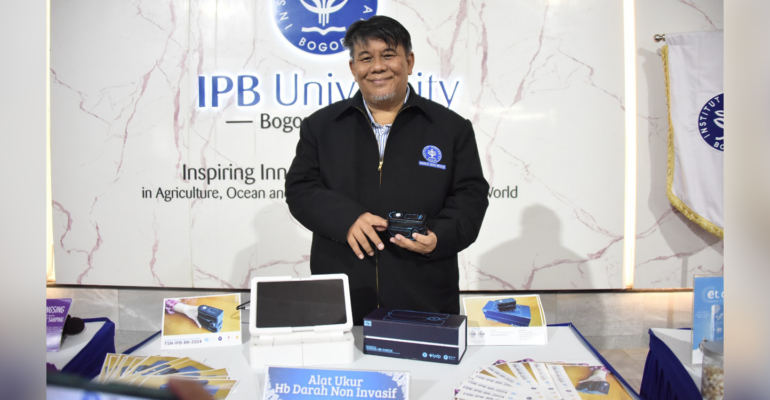Collaboration of IPB University Researchers to Create an Injectable Hb Measurement Tool, Could Be a Solution to Prevent Stunting

Anaemia is a condition when haemoglobin levels in the blood are less than the normal value. If not addressed immediately, anaemia can have a negative impact on a person’s quality of life. Therefore, it is necessary to detect anaemia early so that patients can immediately take treatment steps to overcome it.
As an early detection of anaemia symptoms, it is necessary to check haemoglobin. However, until now, most haemoglobin measurement tools still use invasive methods that take blood samples by injuring the patient.
Despite its high accuracy, invasive methods have drawbacks, which can cause discomfort and even trauma for some people. For this reason, IPB University Professor Prof Irzaman and his team took the initiative to develop a non-invasive haemoglobin measurement tool that is easy to use and the results are reliable.
“If we observe, many patients are traumatised by the process of taking blood from the vein, and in some cases the position of the vein is not easy to find. This tool is expected to speed up and reduce the trauma of the patient,” he said at the Health Innovation Launching event at IPB Dramaga Campus (23/8).
In its development, the IPB University research team collaborated with the National Research and Innovation Agency (BRIN) and PT Tesena Inovindo. The tool is named Tesena Non Invasive Hb Check.
“The mechanism is quite simple, simply by using light then absorbed by the blood, so we can find out the characteristics of the blood, one of which is the characteristics of the haemoglobin level,” explained Prof Irzaman.
He added, “The use of light has been proven to be quite accurate and precise, and most importantly, it produces data in real time so that people can know their haemoglobin levels right away. It’s different from the lab method where the blood is taken first, the wound is cut, and it takes time.”
Prof Irzaman explained that the advantage of this tool is in the data processing. So, after irradiation, data processing is carried out using machine learning and also fast transformation. The combination of the two, he said, can provide results that have relatively good accuracy and precision.
“The presence of Tesena Non Invasive Hb Check is expected to help the anaemia screening process in health service units so that the anaemia detection process can run faster. This tool will also be developed for individual use so that haemoglobin can be done in real time anywhere and anytime,” he explained.
This tool was made by a consortium team between IPB University, PT Tesena Inovindo and BRIN as partners. Prof Irzaman hopes that this tool can be used by the government widely, especially in health centres or health workers to overcome stunting.
“We know that stunting is a symptom of malnutrition that must be prevented, from the stages of unmarried women and pregnant women. Therefore, hopefully with this tool we can overcome or reduce stunting to close to 0 per cent. Tesena Non Invasive Hb Check can be used easily, precisely, quickly, and reliably,” he said. (*/Rz) (IAAS/RUM)



